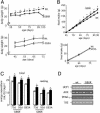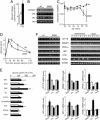Evidence for defective energy homeostasis in amyotrophic lateral sclerosis: benefit of a high-energy diet in a transgenic mouse model
- PMID: 15263088
- PMCID: PMC503756
- DOI: 10.1073/pnas.0402026101
Evidence for defective energy homeostasis in amyotrophic lateral sclerosis: benefit of a high-energy diet in a transgenic mouse model
Abstract
Amyotrophic lateral sclerosis (ALS) is an adult-onset neurodegenerative disease characterized by selective loss of motor neurons and progressive muscle wasting. Growing evidence indicates that mitochondrial dysfunction, not only occurring in motor neurons but also in skeletal muscle, may play a crucial role in the pathogenesis. In this regard, the life expectancy of the ALS G93A mouse line is extended by creatine, an intracellular energy shuttle that ameliorates muscle function. Moreover, a population of patients with sporadic ALS exhibits a generalized hypermetabolic state of as yet unknown origin. Altogether, these findings led us to explore whether alterations in energy homeostasis may contribute to the disease process. Here, we show important variations in a number of metabolic indicators in transgenic ALS mice, which in all shows a metabolic deficit. These alterations were accompanied early in the asymptomatic phase of the disease by reduced adipose tissue accumulation, increased energy expenditure, and concomitant skeletal muscle hypermetabolism. Compensating this energetic imbalance with a highly energetic diet extended mean survival by 20%. In conclusion, we suggest that hypermetabolism, mainly of muscular origin, may represent by itself an additional driven force involved in increasing motor neuron vulnerability.
Figures




References
-
- Brooks, B. R., Sanjak, M., Belden, D., Juhasz-Poscine, K. & Waclawik, A. (2000) in Amyotrophic Lateral Sclerosis, eds. Brown, R. H., Jr., Meininger, V. & Swash, M. (Dunitz, London), pp. 31–58.
-
- Rosen, D. R., Siddique, T., Patterson, D., Figlewicz, D. A., Sapp, P., Hentati, A., Donaldson, D., Goto, J., O'Regan, J. P., Deng, H. X., et al. (1993) Nature 362, 59–62. - PubMed
-
- Gurney, M. E., Pu, H., Chiu, A. Y., Dal Canto, M. C., Polchow, C. Y., Alexander, D. D., Caliendo, J., Hentati, A., Kwon, Y. W., Deng, H. X., et al. (1994) Science 264, 1772–1775. - PubMed
-
- Wong, P. C., Pardo, C. A., Borchelt, D. R., Lee, M. K., Copeland, N. G., Jenkins, N. A., Sisodia, S. S., Cleveland, D. W. & Price, D. L. (1995) Neuron 14, 1105–1116. - PubMed
Publication types
MeSH terms
Substances
LinkOut - more resources
Full Text Sources
Other Literature Sources
Medical
Molecular Biology Databases
Miscellaneous

